Have you ever admired the captivating beauty of succulents adorning a windowsill, a bookshelf, or an office desk? Their diversity of shapes, sizes, and colors makes them incredibly popular as houseplants.
But, do succulents clean the air?
Yes, succulents clean the air, in fact these charming plants offer more than just aesthetic appeal. Generally plants have been long celebrated for their air-purifying properties, and succulents are no exception.
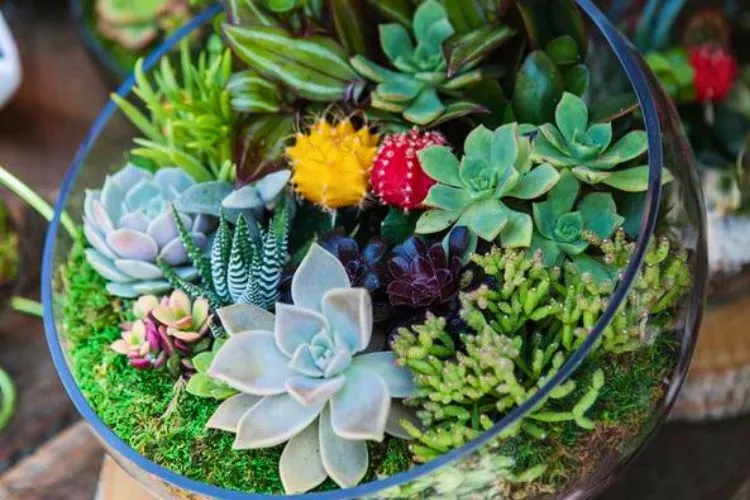
You’re in the right place if you’re troubled by indoor air quality or simply curious about the multi-faceted benefits of your favorite houseplants.
Join us as we explore the scientific evidence behind succulents’ role in enhancing the air quality we breathe daily.
Table of Contents
How Plants Purify the Air?
To understand the air-purifying properties of plants, we need to delve into a bit of botany, starting with photosynthesis. This miraculous process allows plants, including succulents, to convert sunlight, water, and carbon dioxide (CO2) into food – or glucose.
Oxygen, a byproduct of this process, is released back into the environment. This exchange is vital as it contributes to the oxygen content in our atmosphere and helps reduce the levels of CO2, a common indoor air pollutant.
However, the role of plants in air purification extends beyond this photosynthetic exchange. A lesser-known process called transpiration also plays a crucial role in enhancing air quality.
Through this process, plants absorb water through their roots and release it as moisture vapor from their leaves. This can help improve indoor air humidity, which is particularly beneficial in dry environments due to artificial heating or cooling systems.
But plants are not just passive humidifiers and oxygen producers. They also actively remove harmful substances from the air, notably volatile organic compounds (VOCs).
VOCs are a broad group of chemicals, often released from everyday household items such as cleaning products, paints, or cooking fumes. Exposure to high levels of these compounds can lead to health issues, including headaches and respiratory problems.
Some research suggests that plants can absorb these harmful VOCs through their leaves, then transfer them to their root zone, where microorganisms break them down. This process is another way our leafy friends contribute to purifying the air.
So, we know plants have these air-cleaning mechanisms, but where do succulents fit into this picture? Let’s dive deeper into this fascinating group of plants.
The Benefits of Succulents as Houseplants
While their potential air-purifying properties are enticing, succulents bring many other benefits when chosen as houseplants. Their versatility and resilience make them an excellent choice for seasoned plant enthusiasts and those new to indoor gardening.
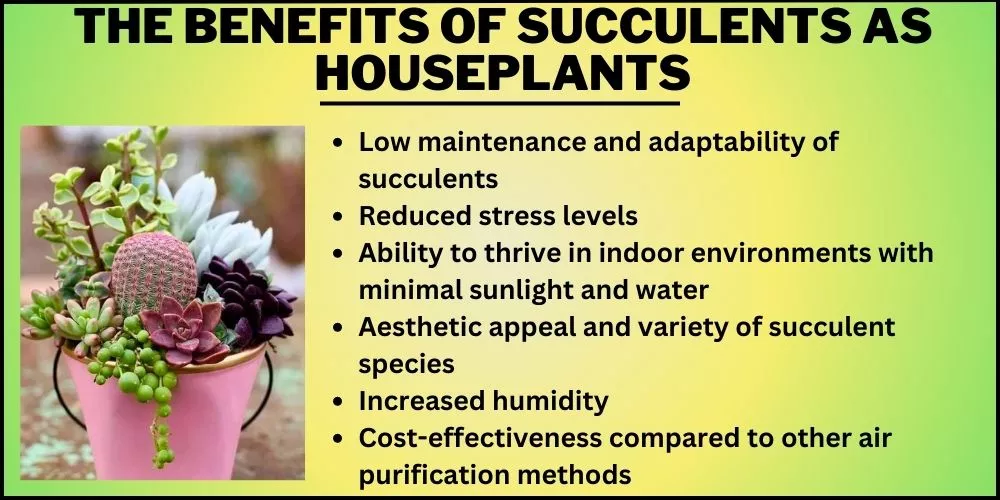
The following section explores these advantages in detail, shedding light on why succulents are so much more than just pretty decor.
Explore how these captivating plants can enhance your indoor spaces and overall well-being.
Low maintenance and adaptability of succulents
Succulents’ hardiness and adaptability are part of their charm. Originating from arid regions, they’ve evolved to store water in their fleshy leaves, stems, or roots, making them incredibly resilient.
These low-maintenance plants require less frequent watering than other houseplants, making them a great choice for those with a busy schedule or the forgetful waterer.
They can also adapt to various indoor conditions, reducing the need for meticulous care.
Reduced stress levels
Bringing a touch of nature into your living space does more than enhance the room’s aesthetics. Studies have shown that interacting with plants can help lower stress and improve mood.
The calming presence of succulents, unique forms, and soothing color palettes can create a serene, relaxing environment.
Caring for these plants can be a therapeutic routine, providing a pleasant, mindful break from our often hectic daily lives.
Ability to thrive in indoor environments with minimal sunlight and water
Succulents are survival experts. Many succulents thrive in indoor settings with less than ideal light conditions. Their ability to tolerate lower light conditions and their water-efficient nature make them suitable for indoor environments where other plants might struggle.
So, whether your apartment lacks ample sunlight or you’re often away, succulents remain a viable, vibrant choice.
Aesthetic appeal and variety of succulent species
With thousands of varieties, each with its unique shape, size, and color, succulents offer endless possibilities for indoor decor.
From the striking symmetry of Echeveria to the intriguing trailing strings of Senecio rowleyanus, or String of Pearls, there’s a succulent to match every aesthetic preference and design vision.
Their versatility allows creative arrangements that transform a space and add a personal touch.
Increased humidity
Despite their desert origins, succulents can increase indoor humidity through transpiration, as they release water vapor into the air. In indoor environments, especially those with air conditioning or central heating, the air can dry, leading to skin irritation and respiratory discomfort.
Having succulents around can help mitigate this by adding much-needed moisture to the air.
Cost-effectiveness compared to other air purification methods
While air purifiers and HVAC systems can do an excellent job of improving air quality, they can also be quite costly in terms of initial investment and ongoing maintenance.
Succulents, on the other hand, offer a cost-effective and visually pleasing alternative. Although not a complete substitute for air purifiers, they can supplement these systems, improving air quality while adding natural beauty to your surroundings.
Do Succulents Clean the Air: What Does The Research Say?
As we embrace the concept of green living, the idea that our houseplants, including succulents, might improve air quality is truly enticing.
But what does the scientific community say about this? NASA conducted one of the most cited studies in this realm in the late 1980s.
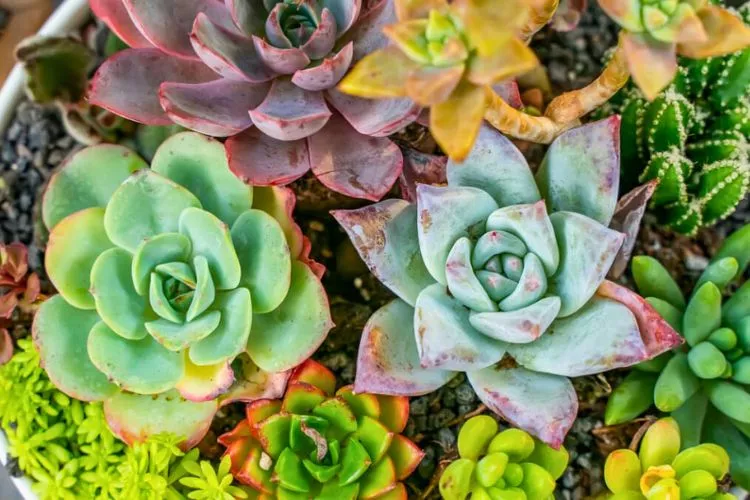
The study aimed to find ways to purify the air in space stations. While the study didn’t focus on succulents, it revealed that some plants could absorb pollutants, particularly VOCs, through phytoremediation.
Phytoremediation, as mentioned earlier, involves plants absorbing pollutants and moving them to their root zone, where microbes break them down.
Although most plants have this capacity to some extent, succulents’ slow transpiration rate makes them less effective at this process than other plants like the Boston fern or the Spider plant.
However, some succulents do stand out in their capacity to improve air quality. The Snake plant, also known as Sansevieria or Mother-in-law’s Tongue, was one of the superstar performers in NASA’s study.
This plant not only releases oxygen at night (making it a great choice for bedrooms) but also absorbs several types of VOCs, including formaldehyde, commonly found in cleaning products, and benzene, found in various types of synthetic fibers and plastics.
Another impressive succulent is Aloe Vera, well-known for its health and skin benefits. This plant has also demonstrated its ability to remove formaldehyde from the air.
It’s important to note that while these succulents can aid in air purification, they cannot entirely replace mechanical air purifiers.
Plants can complement these devices, contributing to a holistic approach to indoor air quality.
In a nutshell, while not all succulents are air-cleaning champions, some species do exhibit these beneficial properties. Their ability to clean the air is just another feather in the cap of these hardy, adaptable, and beautiful plants.
Common Air Pollutants Removed by Succulents
Indoor air quality can be compromised by various pollutants, often without us even realizing it. One primary group of these pollutants is volatile organic compounds (VOCs).
These compounds are emitted as gases from certain solids or liquids, including paints, varnishes, wax, and many cleaning, disinfecting, cosmetic, and degreasing products.
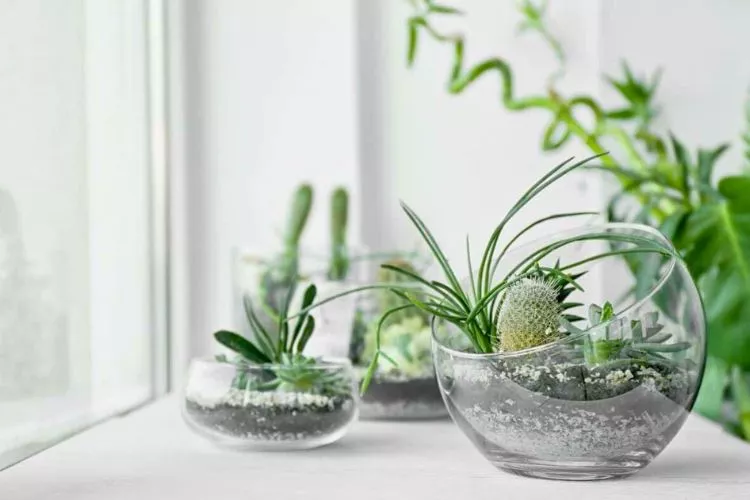
In addition to VOCs, indoor air contains toxins like formaldehyde and benzene. Formaldehyde is commonly found in resins used to manufacture composite wood products, while benzene is often associated with plastics, resins, synthetic fibers, and rubber.
Certain succulents can help mitigate these pollutants. For instance, the Snake plant is known to absorb and neutralize benzene and formaldehyde. The same goes for Aloe Vera, which can also combat formaldehyde.
Remember, while succulents can aid in reducing these pollutants, they are not a complete solution. They best supplement other air-purifying systems, contributing to a comprehensive strategy for improving indoor air quality.
Succulents provide a natural, low-cost, and aesthetically pleasing addition to this mix, making our indoor environments more beautiful and potentially healthier.
Factors Affecting Succulents Air-Purifying Abilities
While it’s clear that certain succulents can help improve indoor air quality, it’s crucial to understand that various factors can influence their air-purifying abilities.
- Firstly, the size and maturity of the plant play a significant role. Larger and more mature plants generally have a greater surface area of leaves for absorbing pollutants and are often more effective air purifiers. It’s not just about having a plant; it’s about the size and maturity of that plant.
- Secondly, indoor conditions can affect a succulent’s air-purifying capabilities. Factors such as light, temperature, and humidity can influence the rate of photosynthesis and transpiration, which, in turn, can impact the plant’s ability to absorb and neutralize pollutants.
- Lastly, the number of plants can make a difference. While a single Snake plant or Aloe Vera can start making a difference, the air-purifying effect will be more noticeable with more plants. However, it’s crucial to strike a balance and not overcrowd your space, as each plant also needs adequate light and air circulation to thrive.
Pro Tips for Using Succulents to Clean the Air
Making the most of succulents’ air-cleaning abilities requires more than bringing them home. Here are some pro tips to help you maximize these benefits:
- Strategic Placement: Place your succulents in areas where pollutants are likely to be concentrated, such as near electronics, in the kitchen, or near new furniture. Succulents can also thrive in bedrooms due to their unique ability to produce oxygen at night.
- Choose the Right Species: Not all succulents have the same air-purifying capabilities. Choose species known for this benefit, such as the Snake plant or Aloe Vera.
- Regular Maintenance: Proper care ensures your succulents stay healthy and can purify the air effectively. This includes watering them correctly (remember, overwatering is a common mistake with succulents) and providing the right light.
- Create a Succulent Garden: More plants can potentially mean more air purification. Creating a small indoor succulent garden can be a visually appealing way to boost your home’s air quality.
- Patience is Key: Remember that plants take time to grow and mature. The air-purifying effects might not be immediate, but with time and proper care, your succulent can contribute to a healthier indoor environment.
Remember, succulents are a natural and cost-effective way to assist in air purification, but they are not a substitute for proper ventilation and air cleaning systems. Use them as part of a comprehensive approach to maintaining good air quality in your home or office.
Which Succulents are the Best Air Purifiers?
While succulents are celebrated for their low maintenance needs and aesthetic appeal, not all carry the same prowess when it comes to air purification.
Some species stand head and shoulders above the rest, boasting scientific backing for their air-cleaning capabilities.
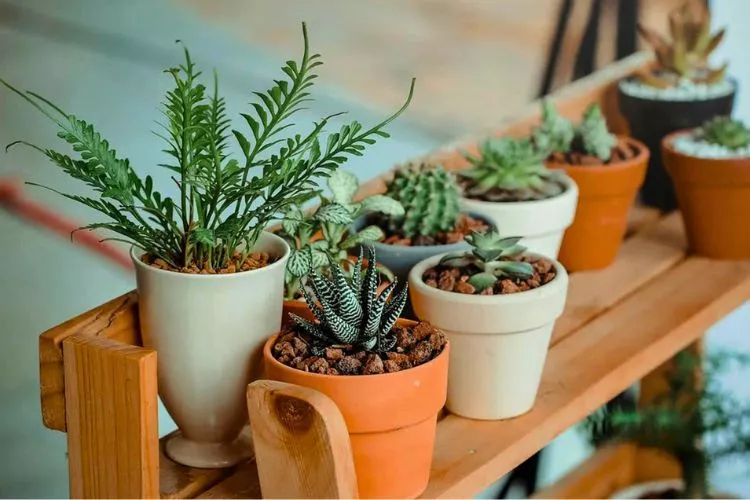
So, identifying these species becomes pivotal if you’re looking to harness the benefits of cleaner indoor air alongside your love for succulents. Let’s delve into the world of air-purifying succulents and identify the ones that can make a difference.
Aloe vera
Aloe Vera is renowned for its health benefits, but its air-purifying prowess is equally impressive. This resilient succulent effectively absorbs airborne compounds such as formaldehyde and benzene, commonly found in paints and certain chemical cleaners.
Its easy care and low-light tolerance make it a perfect addition to any indoor environment.
Snake plant
Known for its tall, striking leaves, the Snake Plant (also known as Mother-In-Law’s Tongue) is a powerful ally for indoor air quality. It’s one of the few plants that convert carbon dioxide into oxygen at night, making it ideal for bedrooms. Additionally, it excels at filtering out common toxins such as formaldehyde and xylene.
Spider plant
Boasting an arching mass of lush, green foliage, the Spider Plant adds visual appeal while tackling air quality. Noted for its ability to absorb carbon monoxide and xylene, it’s an excellent choice for home and office spaces. Additionally, its high transpiration rate helps to increase humidity, which is beneficial in dry environments.
English ivy
With its trailing vines and heart-shaped leaves, English Ivy is more than just a decorative plant. Its real beauty lies in its ability to absorb toxins, particularly formaldehyde, in household cleaning products. It’s also beneficial for those with allergies, as it can help reduce airborne mold and feces particles.
Peace lily
The Peace Lily is not just a charming, flowering houseplant. It is also a robust air purifier, adept at removing toxins like benzene, formaldehyde, and ammonia from the air. This plant does more than just detoxify – it also helps to increase overall indoor humidity levels, creating a healthier environment.
Boston fern
The Boston Fern, famous for its lush fronds, is also an indoor air quality champion. It removes formaldehyde, a common indoor air pollutant, and acts as a natural humidifier, helping restore moisture in air-conditioned or heated rooms. Despite its tropical origins, it adapts well to indoor environments.
Gerbera daisy
The vibrant and colorful Gerbera Daisy isn’t just a visual delight. This flowering plant is also a powerful air purifier. It’s particularly effective at removing benzene, a pollutant associated with inks and synthetic fibers. Like the Snake Plant, Gerbera Daisy releases oxygen at night, promoting better sleep.
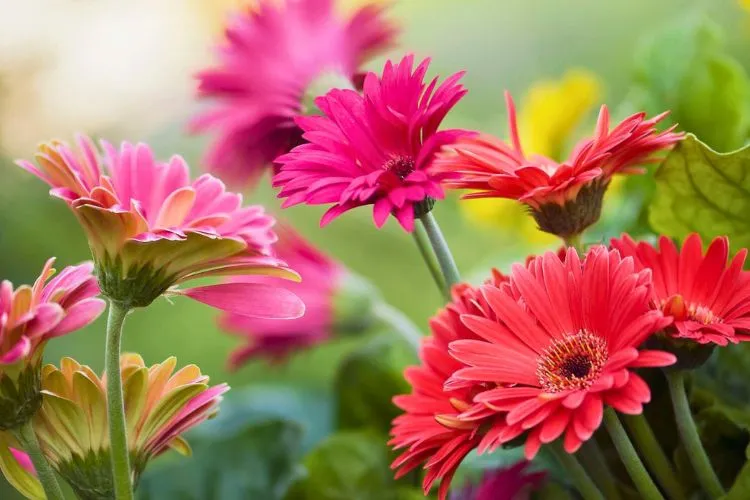
Bamboo palm
The Bamboo Palm, also known as the Reed Palm, is an indoor plant superstar. It stands out for its ability to filter formaldehyde, benzene, and trichloroethylene, toxins often associated with furniture and carpeting. Its lush, tropical appeal and ability to thrive in indirect light make it a popular choice for interior decoration.
Frequently Asked Questions (fAQs)
Can succulents eliminate indoor air pollution?
While succulents can significantly reduce indoor air pollutants, they can’t eliminate them. They should be used as part of a comprehensive air quality strategy, including proper ventilation and reduced use of chemical-based products.
How many succulents do I need to clean the air in a room?
The number depends on the room size and the species of succulents. Generally, having at least two medium-sized plants for every 100 square feet (9.3 square meters) can help improve air quality.
Can succulents remove allergens from the air?
Some succulents like English Ivy can reduce allergens like mold and feces particles. However, it’s important to note that while they can reduce allergens, they can’t eliminate them.
What are the signs that my succulent is actively purifying the air?
There aren’t visible signs of air purification, as the process occurs on a molecular level. However, improved air quality, reduced allergies, and better sleep might indicate effective air purification by your succulents.
Conclusion:
As we’ve seen, succulents offer a low-cost, low-maintenance, and aesthetic solution for purifying indoor air.
Their capacity to absorb toxins while adding moisture and oxygen to the environment makes them worthy additions to your indoor spaces.
With various species to choose from, each with unique purifying abilities, there’s a succulent for every home and office.
The future of air purification may be greener, more natural, and more beautiful with succulents. We hope that this guide has been helpful. You can read about similar topics here on our website. Check back again soon for more.


